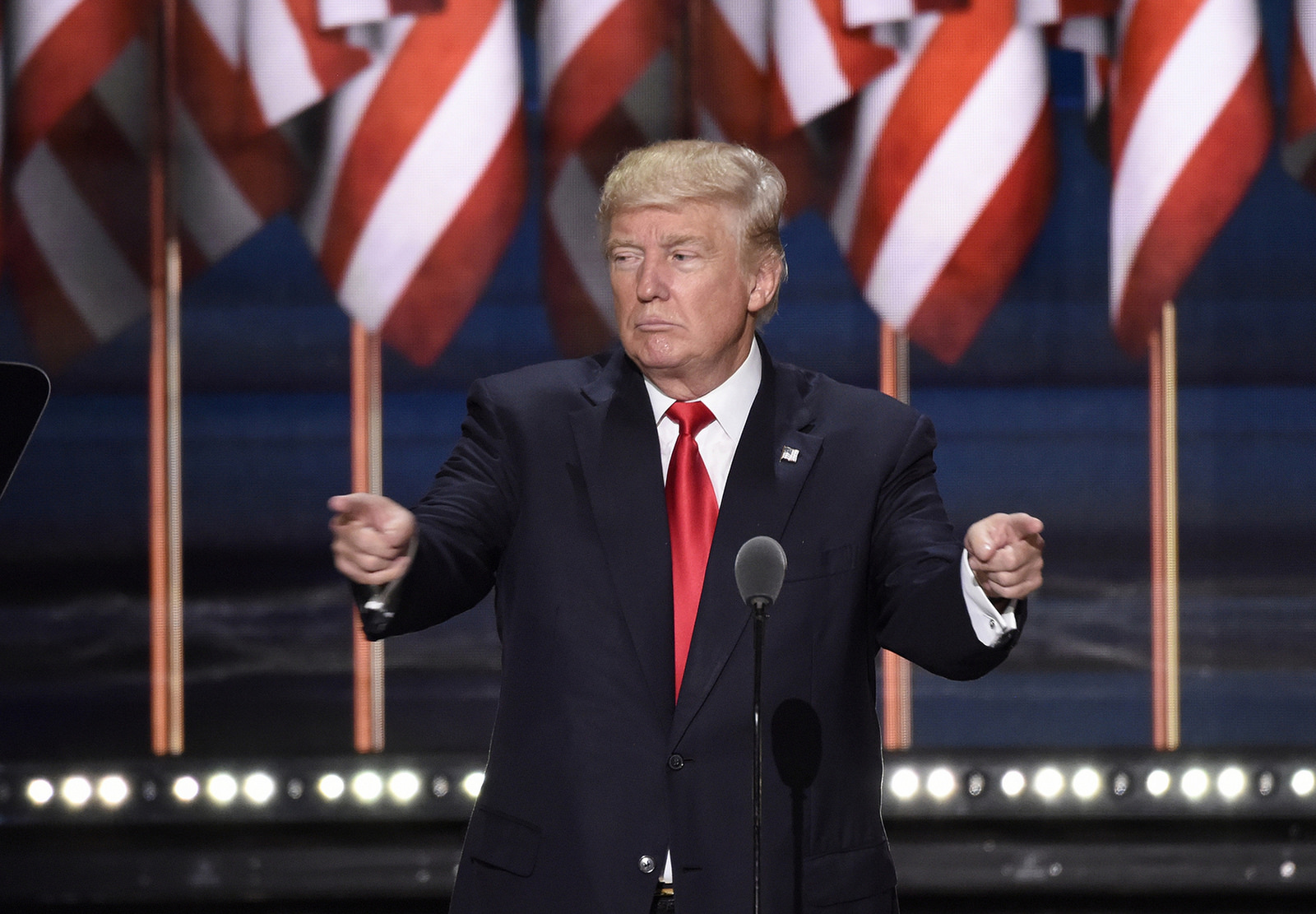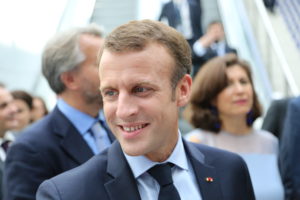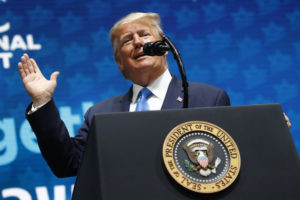How ‘Russiagate’ Helped Secure a Dangerous Arms Deal
Both Barack Obama and Donald Trump resisted sending weapons to Ukraine. Then the investigation into Trump-Russia collusion was launched. Candidate Donald Trump at the 2016 Republican National Convention. (ABC News / Flickr)
Candidate Donald Trump at the 2016 Republican National Convention. (ABC News / Flickr)
Dec. 18 was a day like any other in the Donbas region, the flashpoint of a grinding civil war between the Ukrainian military and pro-Russian separatists. That afternoon, a girl was badly wounded by a shell fired by Ukrainians into the separatist-held Golmovsky. A few hours later, a hail of Grad rockets fired by pro-Russian forces poured down on the Ukrainian-controlled town of Novoluhanske, killing eight civilians in the middle of a community celebration and damaging over 100 buildings. The shelling continued into the night, killing three in the pro-Russian town of Stakhanov, including a 94-year-old woman.
Artillery exchanges like this have become a tragic routine in Donbas. Though the killing has slowed since the heaviest fighting, which occurred in 2015, over 10,000 have fallen in the conflict, and at least 1.4 million have been turned into refugees. With the war entering its fourth year, a decision by the Trump administration virtually ensured that the news from Donbas will grow dramatically worse. Last month, the State Department approved the transfer of $50 million worth of lethal weapons to the Ukrainian military. Along with a shipment of M107A1 Barrett sniper rifles, the United States will be delivering 35 FGM Javelin anti-tank launching systems and 210 missiles.
Though the Javelin has scarcely been tested against the latest models of Russian tanks, advocates of the arms transfer have insisted that the missiles will save lives by deterring the Russians. After a meeting last June with House Majority Leader Paul Ryan and Sen. John McCain, Andriy Parubiy, who is the speaker of the Ukrainian Parliament (and a veteran Nazi activist), presented the Javelins as a game changer. “If we’d burned several hundred Russian tanks [in 2015], it would have been an important step toward restoring peace in our country’s east,” Parubiy declared.
But others who have witnessed the grueling war of attrition from the front lines dread the prospect of new arms on the battlefield. Brian Milakovsky, a Fulbright scholar who is working with an aid organization on the Ukrainian side of Donbas, told me the Javelins would provoke Russia to escalate its military involvement and dramatically deepen suffering on both sides.
“In the time I’ve been in the Donbas there have been escalation events that, when the dust settled, seemed attributable to the separatists trying to improve their positions. There have also been escalations related to the Ukrainians trying to improve theirs,” Milakovsky said. “No one can ever be certain who starts shooting, but you can triangulate a lot of sources and get a sense for it. What I worry about with U.S. arms is how they could inspire more such attempts, which often blow up into artillery duels that damage front-line communities on both sides. Giving just enough arms to make that possible, but not enough to actually change the balance in the war, doesn’t seem responsible to me.”
According to Milakovsky, Russia’s massive military presence gives it an automatic advantage that renders any infusion of outside arms futile. “I think Russia will always be able to pour more arms into the region considering how much of their standing army is positioned just across the border,” he explained. “Both sides are so dug in for a big fight that every escalation is like throwing matches around in dry grass. No one seems to actually want a big war, but no one can accept major moves in the front line either, and they will respond accordingly.”
Milakovsky is hardly alone in this view. “On both sides, we repeatedly heard calls to resume this war. And we thought: If the war returns, no one of those with whom we spoke will survive,” correspondents from the Russian opposition paper Novaya Gazeta wrote in a dispatch from the front lines of Donbas in 2016. Even mainstream American analysts like Council on Foreign Relations fellow Charles Kupchan have warned that “sending lethal weapons to Ukraine is a recipe for military escalation and transatlantic discord.”
Back in 2015, when Kupchan served in Barack Obama’s National Security Council, the then-president made a rare departure from conventional Beltway foreign policy wisdom and rejected pressure to ship lethal arms to Ukraine. The plan to up-arm Ukraine had been developed by the Brookings Institution and the NATO-funded Atlantic Council and was advanced by Congress in the form of a provision by Sen. McCain that would have required the U.S. to budget 20 percent of all aid to Ukraine for offensive weapons.
Obama’s refusal to authorize the arms shipment kept alive the Minsk II peace process, along with the prospect of U.N. peacekeepers deploying to Donbas, a proposal endorsed by Russia. It also infuriated U.S. neoconservatives and more than a few anti-Russian liberals. But once the 2016 presidential campaign got underway, the bipartisan war party was confident its demands would be met.
Once the Democratic and Republican conventions rolled around, both parties’ draft platforms contained nearly identical language promising arms to Ukraine. The arms transfer had been a personal priority of Hillary Clinton, a top recipient of weapons industry cash, since early 2015. Only hours after the Republican National Convention rang its opening bell, however, a Donald Trump foreign policy adviser named J.D. Gordon ordered the RNC to alter its pledge for “lethal weapons” to a call for “appropriate assistance” to the Ukrainian military. Though Trump said later that he was unaware of the change, Gordon claimed the candidate had demanded it to conform to his stated support for detente with Russia.
Despite the softened language on lethal arms, the RNC plank hardly was part of a George McGovern-style peace platform. Gordon inserted language demanding “increasing sanctions, together with our allies, against Russia unless and until Ukraine’s sovereignty and territorial integrity are fully restored.” What’s more, the platform slammed Russia for “occupying parts of Ukraine and threatening neighbors from the Baltic to the Caucasus.” But the minor tweak was enough to inspire The Huffington Post to proclaim in a headline, “The Real Winner At The GOP Convention Is Vladimir Putin.”
A vicious backlash was brewing against Trump’s moves toward detente, and when Clinton’s campaign went down in flames, “Russiagate” erupted. Desperate for evidence of Trump-Russia collusion, Democrats latched on to the dossier produced by Christopher Steele, a former agent of Britain’s MI5 who was funded by a law firm closely tied to Clinton and the Democratic National Committee. According to the error-laden dossier, “the TRUMP team had agreed to sideline Russian intervention in Ukraine as a campaign issue” in exchange for a Russian promise to sabotage Clinton’s campaign.
In March, when the House Intelligence Committee opened its investigation into allegations of Russian meddling in the U.S. election, ranking member Rep. Adam Schiff zeroed in on the conspiracy theory. “Now is it possible that the removal of the Ukraine provision from the GOP platform is a coincidence?” Schiff wondered aloud. “It is possible. But it is also possible, maybe more than possible, that they are not coincidental, not disconnected and not unrelated and that the Russians use the same techniques to corrupt U.S. persons that they employed in Europe and elsewhere.”
Schiff’s diatribe before a congressional gallery packed with camera crews made him an overnight star of the Russiagate drama. He had once been “a milquetoast moderate,” as journalist Ryan Lizza put it, but through his grandstanding, the once obscure centrist suddenly “emerged as an unlikely face of Democratic resistance to the new President”—a “liberal hero,” according to Lizza. There was more to Schiff’s burgeoning obsession with Russian meddling than his own sense of vanity, however.
Since entering Congress in 2002, Schiff hasn’t met a war he didn’t like. He has backed the invasion of Iraq, cheered on NATO’s regime change operation in Libya, heartily endorsed the U.S.-Saudi war on Yemen, clamored for direct U.S. intervention in Syria and lent his signature to virtually every AIPAC-crafted resolution that has landed on his desk.
And the arms industry has rewarded Schiff handsomely, pumping over $70,000 into his campaign coffers in 2016. Schiff’s largest donor this past campaign cycle, at $12,700 [individuals plus PACs], was Northrop Grumman, the defense giant. Raytheon—the manufacturer of the Javelin anti-tank missile system—was close behind it, with $10,000 in contributions [PACs]. In all, arms giants accounted for over one-sixth of Schiff’s total donations.
Back in 2013, Schiff was treated to a $2,500-per-head campaign fundraiser by a Ukrainian-born, California-based arms merchant named Igor Pasternak. The war in Donbas has been a boon for Pasternak, earning him a lucrative contract to supply the Ukrainian State Border Guard with integrated surveillance systems, and a subsequent deal to help replace the Ukrainian military’s AK-47 rifles with a version of the M-16.
Given Schiff’s history, it was little surprise when he thrust himself headlong into the paranoid theater of Russiagate. By casting suspicion on every attempt at diplomacy and driving the resurgence of Cold War hostility between Washington and Moscow, he was poised to deliver another cash cow to his benefactors in the arms industry.
This year’s budget-busting National Defense Authorization Act reflected the Russia panic that gripped Washington. The legislation was filled with provisions for expensive new programs aimed at countering Russian influence and even ferrying Ukrainian soldiers to American hospitals. Though the shipment of Javelins had been left out, the pressure on the White House was about to rise again.
In November 2017, Schiff summoned J.D. Gordon, the former Trump campaign aide, to be interviewed by the House Intelligence Committee. Citing House staffers, Politico reported that Schiff was investigating “whether Trump campaign officials made the Republican Party platform more friendly to Russia as part of some broader effort to collude with the Kremlin.” Robert Mueller, the leader of the federal investigation into Russian meddling, was also expected to probe Gordon for answers about the platform change.
At the time, Trump was under pressure from his envoy to Ukraine, Kurt Volker, to send the Javelins to Kiev. A veteran neoconservative activist, Volker was still listed as the executive director of the McCain Institute for International Affairs when he was installed in Trump’s State Department. Among the McCain Institute’s financial backers was the BGR group, whose designated lobbyist, Ed Rogers, was a lobbyist for Raytheon—the company that would reap a windfall profit from the Javelin sale.
Cornered, Trump risked inviting more allegations of collusion by refusing to arm Ukraine. As Andrew Weiss, a Russia analyst at the Carnegie Endowment for International Peace, told reporter John Hudson, “Overall, I see this discussion [on Trump-Russia collusion] as fitting within a broader effort by people within the national security bureaucracy to box Trump in on Ukraine.”
In November, just weeks before caving in to the pressure to send the Javelins to Kiev, Trump was widely ridiculed when he warned that “people will die” because of Russiagate. But in Donbas, where a war-weary population lives on the brink of another bloodbath, the president could prove his critics wrong in a way they never imagined.
Max Blumenthal is a senior editor of the “Grayzone Project” at AlterNet and the award-winning author of “Goliath,” “Republican Gomorrah” and “The 51 Day War.” He is the co-host of the podcast “Moderate Rebels.” Follow him on Twitter at @MaxBlumenthal.
Your support matters…Independent journalism is under threat and overshadowed by heavily funded mainstream media.
You can help level the playing field. Become a member.
Your tax-deductible contribution keeps us digging beneath the headlines to give you thought-provoking, investigative reporting and analysis that unearths what's really happening- without compromise.
Give today to support our courageous, independent journalists.






You need to be a supporter to comment.
There are currently no responses to this article.
Be the first to respond.